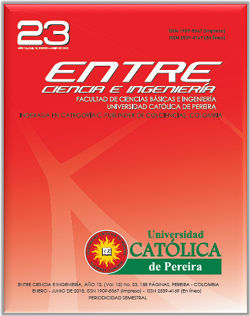Modal analysis of bioepoxy resin/fi que fi ber composite modal analysys
DOI:
https://doi.org/10.31908/19098367.3706Keywords:
Modal analysis, bioepoxy, composite, finite elements, Euler-Bernoulli, fique, frequency response measurementAbstract
In this work, a modal analysis was applied on a bioepoxy/ fi ber composite material using the simulation (Finite Elements), experimentation and analytical modeling knowing the deviation between each of the methods of the solution. The material was elaborated using a bioepoxy resin and fi que fi bers in the distribution of weave under the technique of manufacturing the infusion vacuum. Tensile tests were performed on the composite material according to ASTM D3039 / D3039M to obtain the mechanical properties that allow the development of the mathematical model and the simulation and analysis of scanning electron microscopy to observe the adhesion between the fi ber and the matrix. The experimental modal analysis was performed by measuring the frequency response (FRF) under ISO 7626-2. The Euler-Bernoulli equation was used for analytical modeling, while the ANSYS fi nite element software was used for the simulation. It concludes that for the fi rst modes of material vibration obtained results close between the three methods, however for the third mode the error increases by the interaction between the matrix and the fi ber and the eff ects of the rotation of the cross-section of the test item.
References
Thakur, V. K., Thakur, M. K. “Processing and characterization of natural cellulose fibers/thermoset polymer composites,” Carbohydr. Polym., vol. 109, pp. 102–117, 2014.
Torres, J. P., Vandi, L.J., Veidt, M., Heitzmann, M.T. “The mechanical properties of natural fibre composite laminates: A statistical study,” Compos. Part A Appl. Sci. Manuf., vol. 98, pp. 99–104, 2017.
Vaisanen, T., Das, O., Tomppo, L. “A review on new bio-based constituents for natural fiber-polymer composites,” J. Clean. Prod., vol. 149, pp. 582–596, 2017. Gañán, P., Mondragon, I. “Thermal and degradation behavior of fique fiber reinforced thermoplastic matrix composites,” J. Therm. Anal. Calorim., vol. 73, no. 3, pp. 783–795, 2003.
Muñoz, M. F., Hidalgo, M. A., Mina, J. H., “Fibras de fique, una alternativa para el reforzamento de plásticos. Influencia de la modificación superficial.,” Biotecnología en el Sector Agropecuario y Agroindustrial. vol. 12, no. 2, pp. 60–70, 2014.
Rodríguez, L. J., Sarache, W. A., Orrego, C. E. “Compuestos de poliéster reforzados con fibra de plátano/banano (Musa paradisiaca) modificada químicamente. Comparación con fibra de vidrio y fique (Furcraea andina),” Inf. Tecnol., vol. 25, no. 5, pp. 27–34, 2014.
Gómez, C., Vázquez, A. “Flexural properties loss of unidirectional epoxy/fique composites immersed in water and alkaline medium for construction application,” Compos. Part B Eng., vol. 43, no. 8, pp. 3120–3130, 2012.
Valencia, C. A., Pazos-Ospina, J. F., Franco, E. E., Ealo, J. L., Collazos-Burbano, D. A., García, G. F. C. “Ultrasonic determination of the elastic constants of epoxy-natural fiber composites,” Phys. Procedia, vol. 70, pp. 467–470, 2015.
Navia, D. P., Ayala A. A., Villada H. S. “Effect of cassava flour gelatinization on mechanical properties of bioplastics,” Biotecnol. en el Sect. Agropecu. y Agroindustrial, vol. 13, no. 1, pp. 38–44, 2015.
Hidalgo-Salazar, M. A., Mina, J. H., Herrera-Franco, P. J. “The effect of interfacial adhesion on the creep behaviour of LDPE-Al-Fique composite materials,” Compos. Part B Eng., vol. 55, pp. 345–351, 2013.
Gañán, P., Mondragón, I.. “Influence of Compatibilization Treatments on the Mechanical Properties of Fique Fiber Reinforced Polypropylene Composites,” Int. J. Polym. Mater., vol. 53, no. 11, pp. 997–1013, 2004.
Klimenda, F., Soukup, J. “Modal Analysis of Thin Aluminium Plate,” Procedia Eng., vol. 177, pp. 11–16, 2017.
West, B. M., et al. “Modal analysis of metal additive manufactured parts,” Manuf. Lett., vol. 13, pp. 30–33, 2017.
Minette, R. S., SilvaNeto, S. F., Vaz, L. A., Monteiro U. A., “Experimental modal analysis of electrical submersible pumps,” Ocean Eng., vol. 124, pp. 168–179, 2016.
Weis, P., Kučera, Ľ., Pecháč, P., and Močilan, M. “Modal Analysis of Gearbox Housing with Applied Load,” Procedia Eng., vol. 192, pp. 953–958, 2017.
Senthil Kumar, K., Siva, I., Jeyaraj, P., Winowlin Jappes, J.T., Amico, S. C., Rajini N. “Synergy of fiber length and content on free vibration and damping behavior of natural fiber reinforced polyester composite beams,” Mater. Des., vol. 56, no. October, pp. 379–386, 2014.
Han, S., Benaroya, H., Wei, T. “Dynamics of transversely vibrating beams using four engineering theories,” J. Sound Vib., vol. 225, no. 5, pp. 935–988, 1999.








 Revista Entre Ciencia e Ingeniería
Revista Entre Ciencia e Ingeniería .png) entrecei@ucp.edu.co
entrecei@ucp.edu.co.png) ISSN (Impreso) 1909-8367 - ISSN (En Línea) 2539-4169
ISSN (Impreso) 1909-8367 - ISSN (En Línea) 2539-4169 Attribution-NonCommercial 4.0 International (CC By-NC 4.0)
Attribution-NonCommercial 4.0 International (CC By-NC 4.0)
.png) Carrera 21 No. 49-95 Av. de las Américas, Pereira, Risaralda, Colombia
Carrera 21 No. 49-95 Av. de las Américas, Pereira, Risaralda, Colombia